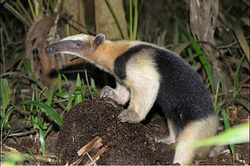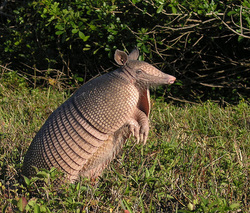 TRENT'S WALK IN THE BELIZEAN JUNGLE (Part One) Is brought to you by "Grand Belizean Estates" the next place to call home. Today's walk in the jungle, produced sightings for two very unusual animals. The anteater and the armadillo, each native to Belize.  ANTEATER SIGHTING Here is a picture of a Belizean anteater. Anteaters are native to Belize, and called in Spanish hormiguero, or ant-er (by the locals). An ant-er is a friend to anyone who owns a wooden house here. These bushy mammals have a specially long snout, to poke their noses into other peoples business. Couldn't resist the play on words. Anteaters eat termites and for many folks down here, that makes these animals your new best friend. Fairly easy going creatures, they have a elongated nose, which is heavily coated with saliva. This obviously is to their advantage, as they lick up those termites and ants. Tiny projections on the tongue, aimed towards the throat, keep the ants marching in the right direction (right down the anteaters throat); down the gullet to a thick-walled, muscular stomach made especially for crushing up the hard exockeletons of insects. Anteaters have a tendency to establish specific routes, both in the trees, and on the ground, which they will travel repeatedly, visiting the same termite and ant colonies over and over again. One species of termites posts soldiers on guard, with their teeth at ready to stand guard against the anteater. Another species of ants has a low chemical defense which, as more and more are consumed, builds up into an accumulative impalatability. By such devices these nests, become only partially depleted at a time, and are able to survive a raid for another day. Anteaters are individualistic creatures, which means, they love to live by themselves. They keep odd hours, according to personal whims. Offspring ride their mother's back, climbing off when they arrive at one or another of her regular restaurants, where they stop for a meal together. Then on to the nearest of her den sites for a rest in a hollow of a tree or a hole in the ground. You can meet an anteater at the Belize Zoo, if it is in the mood to meet you. Otherwise, you might be lucky enough to glimpse its nose poking out into the daylight from its hollow log home.  ARMADILLO SIGHTING This is a picture of an armadillo. Another animal you will no doubt see in the Belizean jungle. This is one of the oddest animals I think I have ever seen in my life. This unlikely-looking mammal is covered head to tail in bony plates, called scutes. The body itself has first a scapular shield, followed by a series of flexible, triangular bands overlain with round, epidermal scales. There is also a pelvic shield to protect the underbelly. All this armor can add up to eighteen pounds, if you include the little guy within. Out from under its visor pokes a long, upturned nose and prominent ears set close together. He reminds me of a baby anteater with a suit of armor. He has four feet, with a total of eighteen very sharp daggers, or should I say diggers. With these it makes its burrow, which may be as much as 25 feet long and 6 feet deep. It will often sit upright on its haunches to test the air (as you see him doing here) for scents. Should it detect the whiff of hostility, it will make a mad dash into the under bush. The armadillo lives in a variety of habitats, the primary requirement being a temperate climate as its body maintains home range is about 13 acres, which it traverses in the night, looking for small tidbits, insects, larvae, snails, worms small vertebrates, fungi, fruits, and berries. HOPE YOU ENJOYED MY WALK IN THE JUNGLE TODAY, AS MUCH AS I DID.
0 Comments
Leave a Reply. |
Trenton Turley
Hi, my name is Trenton S. Turley. I've been living in Belize now for 11 years. Hope you enjoy reading my many blog posts. I write about things, that are passionate to me.
SNAKES OF BELIZE!
Check out, my my current blog series on Snakes of Belize. Categories
All
Archives
April 2016
|

 RSS Feed
RSS Feed